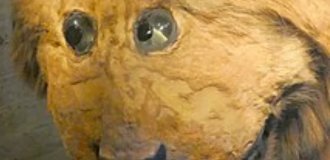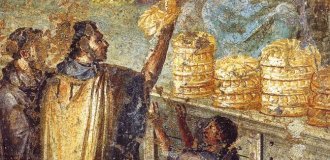5 little-known facts about famous people, characters and inventions (14 photos)
The world around us is full of miracles. 
But they do not manifest themselves in the form of magical or inexplicable phenomena, but in the form of actions, decisions and qualities that either have a logical explanation or will one day acquire one.
1. Translation difficulties 
Bagheera
In Rudyard Kipling's "The Jungle Book," Bagheera is a male character. In our translation, Bagheera's gender has been changed, possibly because the word "panther" is feminine. 
Honest John (right) and Gideon (left) are depicted in the Disney cartoon "Pinocchio"
The swindler's girlfriend, the Fox, from Carlo Collodi's fairy tale "The Adventures of Pinocchio. The Story of a Wooden Doll" in the original Fox. Other male characters are Owl in A.A. Milne's story about Winnie-the-Pooh, the caterpillar and the dormouse from Lewis Carroll's "Alice in Wonderland".
2. Botanical Riddle 
Amazing Plant
When water gets on the petals of Gray's bifolia, they become transparent and resemble mica or glass. This process is explained by the fact that the petals are incredibly thin and consist almost entirely of water. When additional moisture gets into the structure, it fills all the microscopic voids, making them almost invisible to light. As a result, the flower seems glassy. After drying, the petals become white again, returning to their standard appearance.
The nature of this phenomenon has not yet been solved by scientists. But there are several versions. One theory is that a chemical reaction occurs between the surface of the leaves and the water, causing the petals to thin out to the point that they resemble thin plastic film. Another hypothesis suggests that the process is electrical in nature.
3. The Coney Island Show That Saved Thousands of Newborns 
The doctor spent all the money he raised on saving premature babies
The fake doctor charged the public 25 cents to see tiny newborns in incubators, at a time when many doctors were leaving them to die. 
Dr. Martin Couney staged baby incubator shows at Coney Island, Atlantic City, and the World's Fair, charging spectators to see tiny premature babies. Some estimates put the number of premature babies he saved with his incubators at 7,000.
Desperate parents brought Couney their tiny babies, wrapped in towels or hidden in boxes, often rushing from hospitals where they were told the babies would die. 
Coney claimed to have studied in Leipzig, Berlin, and then Paris with Dr. Pierre Boudin, the father of European neonatal medicine, but no records of his work could be found.
4. The Birth of a Legend 
In the late 1950s, two engineers, Alfred Fielding and Marc Chavannes, were trying to create a 3D wallpaper. They tried several different approaches, but without much success. Then one day they tried something unusual - they glued two shower curtains together. 
Alfred W. Fielding (left) and Marc A. Chavannes, inventors of bubble wrap and founders of Sealed Air Corp., circa 1970
When the glue dried, they noticed that the air pockets between the two layers of plastic created the effect they were looking for. They were sure they had finally got it right... After further refining the concept, the guys began selling their textured wallpaper.
Unfortunately, no one was interested, so they began looking for other uses for their invention. At first, the material was sold as insulation. However, its insulation properties were modest at best. 
A Brilliant Invention
Soon after, computer giant IBM announced the release of its new 1401 model. A quick-thinking marketer at Sealed Air (the company the two engineers created to make their unusual wallpaper) saw an opportunity.
He realized that air pockets were ideal for cushioning and protecting fragile items during shipping. Bubble wrap was introduced to IBM for use as packaging when shipping new computers to customers. After failing to create a new style of wallpaper, Fielding and Chavannes developed a miracle packaging material that is still used around the world.
5. The Thing Salvador Dali Feared Most in Life 
"The Persistence of Memory"
Our hopes and fears are brought back to us in Dali's paintings through his intricate and sometimes frightening images. They also give us an insight into the man himself, who boldly poured some of his own fears onto canvas.
Ants and grasshoppers are particularly common motifs in Dali's work, and they appear time and again in his many paintings as dark symbols. For example, among the floating clock dials in Dali's most beloved painting, The Persistence of Memory, the pocket watch in the corner is covered in a swarm of tiny ants. This is no coincidence - Dali was so afraid of insects that it went beyond mere disgust. 
Like many, Salvador Dali was traumatized by creepy crawlies as a child, and this left him with a lifelong fear and fascination. Dali wrote about several disturbing experiences with the bugs in his autobiography, The Secret Life of Salvador Dali, a book that serves as a useful compendium for deciphering his paintings. 
The incident with the ant upset Dali, but much worse than the ants were the grasshoppers - insects that Dali described in the most dramatic language imaginable. Noticing that the tiny faces of grasshoppers resembled the faces of a scary fish he had once caught, Dali became constantly worried about them:
I saw them everywhere, even where they weren't: a grayish piece of paper that suddenly appeared and seemed to me to resemble a grasshopper made me let out a piercing scream that delighted everyone... 
Dali's fear was aggravated by other children who amused themselves by frightening him with insects at every opportunity.
As an adult, Salvador Dali was never able to overcome his fear of bugs. According to the Smithsonian, he may have even suffered from Ekbom syndrome, a rare psychological condition in which patients believe invisible bugs are crawling on their skin.
This posthumous diagnosis was made by Dali in connection with his recollection of a terrifying incident that occurred after he noticed some bugs in a Paris hotel room. Unnerved by the appearance of these creatures, Dali was convinced that the mark on his back was a tick and began to furiously scrape it off with a razor. By the time the doctor arrived, Dali realized:
It was not a bedbug, a tick, a cockroach, or a Siamese twin that had stuck to my skin - all of this existed only in my imagination. It was simply a small birthmark that I had seen hundreds of times before.
























